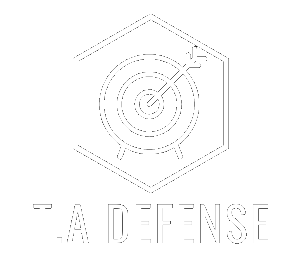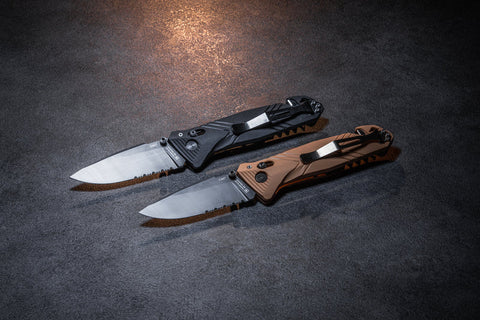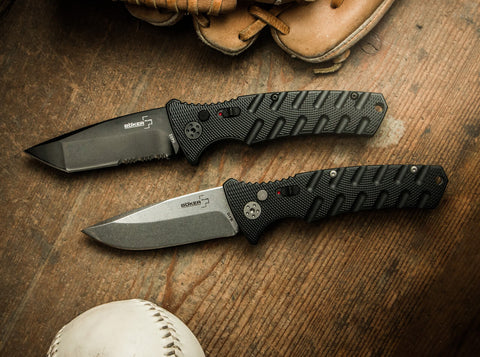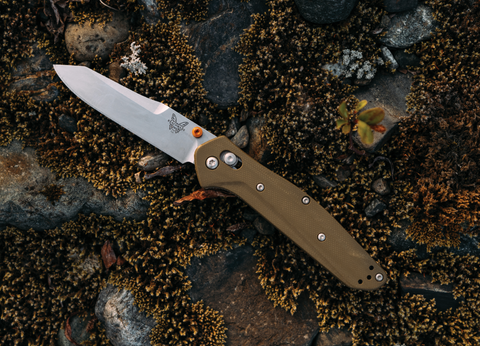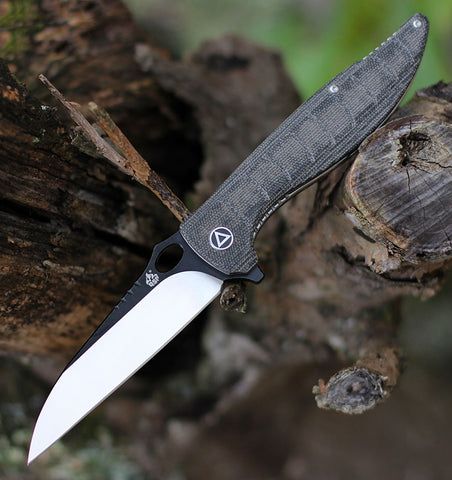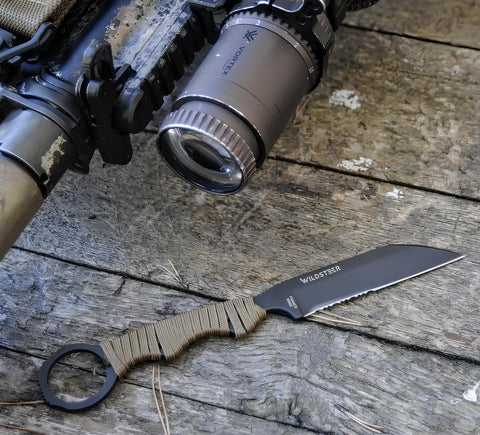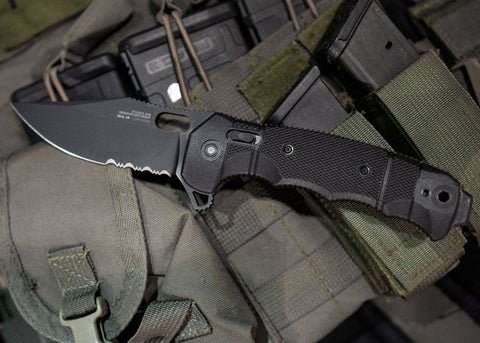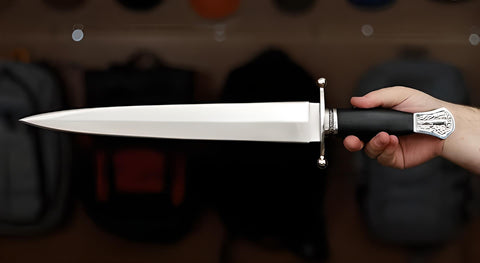Knife blades are much more than simple metal edges; they represent functional and aesthetic diversity. The shape of the blade not only influences how a knife cuts, but also its specific use.
Let's explore the 12 types of knife blade shapes, each bringing its unique benefits.
1. Straight Blade: Versatile Simplicity
Kwaiken Grip Auto automatic knife - Boker
The straight blade, simple and versatile, constitutes the classic knife shape. This blade geometry provides a generous cutting surface, suitable for a variety of tasks, from slicing to dicing. It is characterized by a very simple silhouette, but which has proven itself. The unsharpened spine of the blade follows a straight, unslanted line from its base to the tip. The edge of the blade also follows a straight, non-angled line, but for the upper third, where it slopes upward toward the tip. The long edge of these knives makes them excellent candidates for slicing and cutting tasks. This type of blade is probably the easiest to maintain and is ideal for everyday use.
2. Clip Point Blade: Functional Elegance
Voyager Clip Point folding knife - Cold Steel
The Clip Point blade is one of the most popular blade shapes today, the clip point is found on all types of knives, from tactical fixed blades to folding EDC knives. The unsharpened spine of the blade extends about half its length, before following a concave curve towards its tip. The edge of the blade is mostly straight, with a slight upward slope in the upper third of the blade, towards the tip. This design is ideal for tasks requiring high precision, such as detailed cutting.
3. Drop Point Blade: Robustness and Versatility
CAC S200 blue pointed or round 3 functions - TB Outdoor
The Drop Point blade is known for its sturdier tip that is less likely to break. This shape offers exceptional versatility, and is suitable for a wide range of tasks. It lends itself wonderfully to drilling and slicing, and is very easy to sharpen and maintain. Knives with Drop Point blades are loved by many users for their functionality and adaptability across a range of activities. Whether for daily use, outdoor activities or tactical needs.
4. Spear Point Blade: Symmetrical Balance
Launch 12 automatic knife - Kershaw
5. Tanto Blade: Japanese Elegance
Strike Tanto automatic knife - Boker Plus
Named after a traditional short dagger carried by the samurai of feudal Japan, tanto-style blades have perhaps the most immediately recognizable shape of all common blade types. Typically, the spine of the blade is straight and unsharpened, with a steep angle toward the tip at the top quarter of the blade. Its aesthetic design combines with exceptional functionality, making it a popular choice in tactical knives.
6. Tanto reverse blade: Between Tradition and Modernity
Osborne Auto Automatic Knife - Benchmade
As the name suggests, reverse tanto blades are essentially reverse versions of standard tanto knives. They therefore retain the reinforced tip and the triangular tip of the normal tanto, but the dorsal part of the standard profile has been reversed and now carries a sharpened edge. Features of this blade typically include a very sturdy and powerful tip, making it an ideal option for tasks requiring high penetration force. This blade design also provides great tip strength, which can be useful in situations where the knife tip is subjected to significant loads.
7. Hawkbill Blade: Curvature for Traction
Karambit Bad Moon knife - Böker Plus
With a pronounced outward curvature, the Hawkbill blade excels at pulling and cutting. This design is often used in tactical utility knives for exceptional cutting performance. The back and edge of the blade follow a similar arched slope and end in a fairly radical curved tip. This type of blade is most often found in combat knives, such as the karambit, and is ideal for piercing and especially for slicing while resting on the tip.
8. Wharncliffe Blade: Artisanal Precision
A Wharncliffe blade is characterized by a straight shape without a protruding tip, with a spine descending evenly towards the edge. This design provides a sturdy tip and high cutting precision, making it a popular choice for tasks requiring precise control, such as carving, cutting materials or other tasks requiring fine blade manipulation. Its ease of sharpening and versatility make it a blade appreciated by those seeking optimal functionality.
9. Lame Sheep's Foot: Control and Safety
Leviathan maritime knife - Wildsteer
The primary function of a sheepsfoot blade is to cut and slice while minimizing the chance of being accidentally pierced by the tip. The design of a sheepfoot profiled blade knife includes a straight edge front blade and a blunt rear blade that curves downward to meet the straight edge. The two blades meet at the tip to form a “false tip” (not sharp). The characteristic flat cutting edge is well suited for extremely clean cutting, especially on flat cutting surfaces.
Sheep's foot knives are popular with first responders who use them to cut seat belts and other restraints without injuring the victim with a sharp point. They are also appreciated by sailors who use them to cut rope safely without risking piercing the sails.
10. Serrated Blade: Teeth for Cutting
Seal XR automatic knife mixed blade - SOG
Incorporating saw teeth along the cutting edge, the Serrated blade, also called a combination blade, is a blade whose cutting surface has a serrated edge. Designed to be used as a small saw, with a back and forth motion. Ideal for cutting belts and ropes, fabric and other textured materials. The serrated blade is also very effective on soft, flexible materials or materials that can be easily crushed by a downward cut. Bread, cooked meats, soft fruits and vegetables are good examples of materials that lend themselves well to using a serrated knife.
11. Dagger Blade: Sharp Elegance
Arkansas Toothpick Dagger - Cold Steel
A dagger-shaped blade is characterized by its tapered, symmetrical design, with a central cutting edge and a sharp point. This structure allows the dagger to be used for perforating and cutting tasks with great precision. Often associated with tactical or ceremonial uses, the tapered shape of the blade gives the dagger exceptional maneuverability, while the sharpened tip makes it an effective tool for rapid and targeted actions. Dagger blades are frequently used in military history and are also valued for their distinctive aesthetic.
12. Kukri Blade: Tradition and Power
Kukri USMC knife - United Cutlery
Originating from Nepal, the Kukri blade features an inward curvature with an angled tip. It is a traditional blade known for its cutting power, often used in survival activities. The kukri is a practical utility tool. It prepares food, cuts ropes and serves as a reliable outdoor companion. Its multifunctional design makes it a versatile tool for everyday and adventurous use.

To conclude this detailed exploration, it is evident that each shape of blade meets specific needs, whether for hunting, survival, cooking or other activities. The in-depth understanding of these blade shapes allows knife enthusiasts to choose the perfect tool based on their individual needs, ensuring an optimal using experience.
Knives are not simply tools, but functional works of art, and the diversity of blade shapes adds an aesthetic and technical dimension to each piece. By exploring these 12 blade types, knife enthusiasts can refine their collection and choose the tool that will become an extension of their own expertise and lifestyle. Whether for aesthetics, performance or functionality, the shape of the blade remains a key element that defines the identity and utility of a knife.
Our article did not meet your expectations or do you have a question? Contact our team or leave a comment and ask us your question directly.
See you soon,
